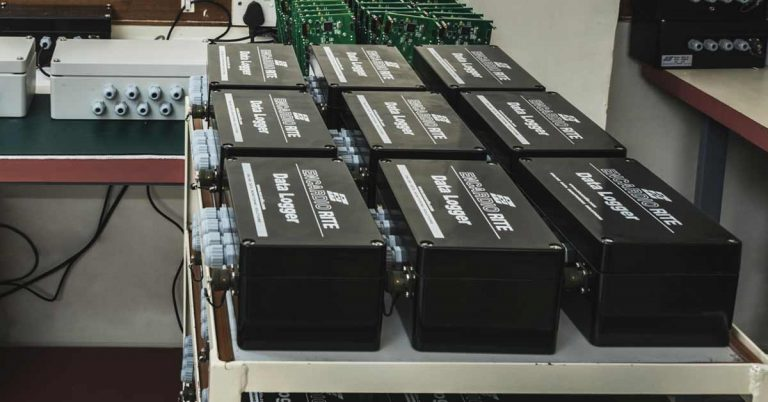
Here is everything that you would like to know about data loggers - their types, relation with the data acquisition system, working principle, specifications, and much more.
What is a Data Logger?
A data logger or a data recorder is an electronic device or a computer program that continuously records data over time about the location either using a built-in instrument or through an externally interfaced one.
The data loggers are primarily based on digital processors and usually look similar to a small portable box/case with batteries, wires, internal memory storage, sensors, and a programmable module.
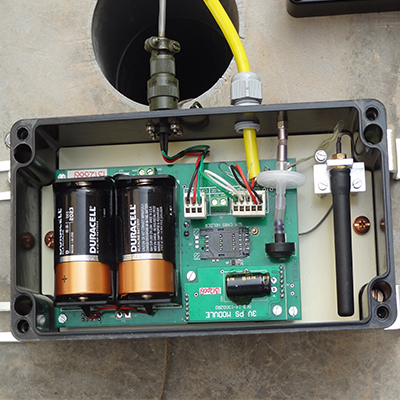 Data Loggers - Encardio Rite
Data Loggers - Encardio RiteFigure 1: Inside of a Data Logger
A few of the data loggers interface with a PC to show data through dedicated software while some others connect directly to a device (LCD, PC, Mobile Phone) and show data as a stand-alone device.
Data Loggers are used in geotechnical monitoring and instrumentation on a large scale because they automatically collect real-time data from the sensors and display it over the mobile device. One can leave the data loggers unattended and can still get the complete data anytime they wish to.
How many data loggers do I need?
The need for data loggers depends upon the number of measurement points that you have or the number of sensors that you want to connect to it. Data loggers are available in multiple configurations so that you can choose according to your needs.
For instance, the ESCL-10VT data logger is a single-channel data logger whereas the ESDL-30 is a multiple-channel data logger with 160 inputs. However, the latter requires an SDI-12 interface to connect with sensors like piezometers, load cells, temperature sensors, etc.
How long can data loggers record?
The duration of data logging depends upon two parameters - the power backup of the data logger and its memory capacity. While most of the data loggers have high longevity and durability, they continue to operate for many years. Whereas, a few of them work for a shorter period only.
The Encardio’s data loggers are battery-operated and they can be programmed to record data from 5 to 168 seconds in linear mode. However, the number of readings taken per day should be kept minimum to save the battery. This data logger also gives you several power supply options.
The sample rate multiplied by the number of channels being recorded gives the length of time the logger can operate before the memory is filled. Some of the data loggers are programmed to over-write the data once the memory is filled while some of them stop logging data once the memory is full.
Where are alarms usually sent?
While monitoring structures like tunnels, dams, high-rise buildings, a certain alert level is pre-determined and, as soon as the deformation or fault reaches beyond that particular level, the data loggers send an emergency alert either through an SMS or an email.
There are a few other data loggers that come with built-in LEDs, alarms, or buzzers to alert local persons in case of an emergency.
How do you retrieve the data?
There are two options available for data retrieval and transmission through Encardio’s data loggers:
1. Telemetry through GSM/GPRS modem: In an area with GSM/GPRS service, the data from the automatic data logger can be transmitted remotely to a PC at a central location. The user will need to arrange a data SIM card for each data logger.
2. Readout/data retrieval using a laptop PC: The logged data from the data logger is directly downloaded to a laptop/PC. Data can also be transferred to the central PC or server from the laptop using either a USB pen drive or through the Internet.
Do you have to learn how to program?
Most of the data loggers these days are configured rather than programmed. Encardio Rite provides a public cloud-based web monitoring service to its customers for retrieving data from ESDL-30 and ESCL-10VT data loggers.
The data retrieved is archived in an SQL database and presented in a graphical or tabular form for easy understanding. The tables and graphs related to any site or sites can be accessed by authorized personnel who can log in to their site using the supplied login ID
Block diagram of a Data Logger
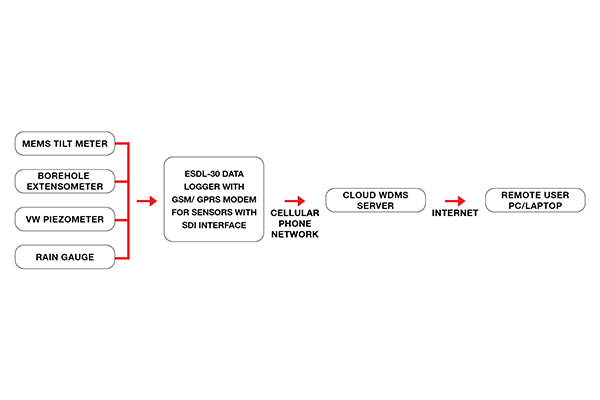
Figure 2: Block Diagram of a Data Logger
These data-logging devices are connected to geotechnical instruments like tilt meters, piezometers, extensometers, etc. These instruments send the measured physical parameters to the data logger.
The signals are then processed by them and further transmitted to a cloud web-based data management system so that you can get the data in readable form on your remote devices.
What are the working mechanisms of data loggers?
Data loggers usually appear like small boxes enclosing batteries for power supply, microprocessors, internal memory storage, sensors, and a programmable module. Encardio Rite has two models of data loggers i.e. ESCL-10VT and ESDL-30.
The ESCL-10VT is a single-channel data logger for vibrating wire sensors which means, it can be directly connected to vibrating wire sensors such as piezometers, strain gauges, extensometers, etc. Whereas, ESDL-30 is an automatic data logger that uses an SDI-12 interface to connect with the sensors.
Once the sensors are connected to the data loggers, the data through these sensors is logged at regular intervals by the data loggers and stored in its internal non-volatile memory. The users can retrieve this data remotely over their mobile devices using Encardio’s cloud service.
While monitoring the structures, a certain alert level is pre-set. If the data logged is beyond the alert levels, an email or SMS emergency alert is sent to the user so that preventive measures can be taken before any mishap or accident.
What is a data logger and what does it do?
Data Loggers are simple yet significant sensors having a wide range of applications in the field of geotechnical monitoring and instrumentation. They can be used to log all sorts of physical data through various instruments and sensors.
Data loggers are used for the following purposes:
- Comprehensive tunnel monitoring for the long-term safety of the tunnel, to study the behavior of the tunnel over time, especially concerning the rheological behavior of the rock mass and obvious changes in the fault zones, walled sections, inflow, etc.
Several instruments such as tilt meters, strain gauges, extensometers, etc. are installed on the inner lining of the tunnels to monitor deformities if any. The data from these sensors is continuously logged by a data logger and stored in its internal memory. - Structural health monitoring of existing buildings to keep track of the building’s performance over time and the effect of nearby construction or excavation. Data loggers create an early warning in case of an emergency so that the user can take preventive measures.
- Landslide monitoring to avoid mishaps and create early warnings so that loss of life and property can be prevented.
- Groundwater monitoring and rainfall management so that the most important freshwater resource can be saved from depleting and there’s an even distribution of the resource among all.
- Monitoring the deformation of land and surrounding areas during deep excavations. Excavation in soft ground induces ground movement which imposes a threat to nearby sensitive structures in the zone of influence. Hence, deep excavation risk assessment and foundation crack monitoring are crucial at all levels.
- Monitoring of deformities in bridges so that early warning can be generated in case of an emergency
- Unattended dam and nuclear power plant monitoring to avoid fatal accidents. Data loggers log data from different sensors and send it to the user’s remote device.
- Unattended weather changing parameters recording through weather stations to aid in agricultural activities.
- Monitoring of relay status in railway signaling
Types of Data Loggers:
Encardio Rite deals with a couple of data loggers that are almost similar to each other and a data acquisition system.
1. Model ESDL-30 Automatic Data Logger for SDI-12 Interface Sensors:
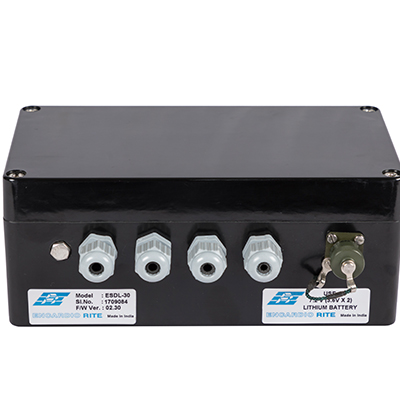
Encardio Rite Model ESDL-30 data logger is designed to log data from sensors with an SDI-12 interface. Any sensor with an SDI-12 signal interface can be connected to the data logger e.g. based on vibrating wire, resistance strain gauge MEMS technology, etc.
ESDL-30 can be used to connect a large number of sensors with the SDI-12 interface. The data recorder is fully compatible with all measurement command signals as per SDI-12 standard.
They can be programmed to measure a range of 5 seconds to 168 hours in linear mode. The number of measurements taken per day should however be minimal because the higher frequency of measurement drains the battery at a faster rate.
The SDI-12 serial digital interface requires a three-conductor cable to connect the sensors to the data logger.
Only a single 3-conductor cable is required to interconnect all the sensors and the data storage devices in a serial bus.
SDI-12 is a multi-drop interface that can communicate with multi-parameter sensors. Multi-parameter means that a single sensor may return more than one measurement, like displacement and temperature from vibrating wire displacement sensors.
All the measured data is stored, together with the current date, time, and battery voltage, as a data record in the internal non-volatile memory of the logging device.
How does the Model ESDL-30 Automatic Data Logger work?
Data Retrieval and Transmission
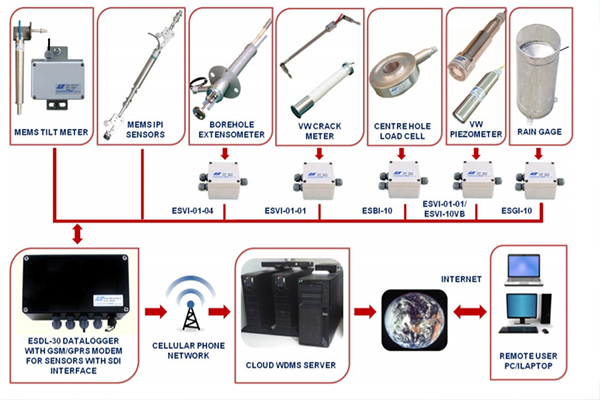
The data retrieval and transmission from Model ESDL-30 can be done in two ways:
- Telemetry through GSM/GPRS modem
In a location covered by any GSM/GPRS service provider, the data from the automatic data logger can be transmitted remotely to a PC at a central location. The user will need to arrange a data SIM card for each data logging instrument.
- Readout/data retrieval using a laptop
The logged data from these devices in the field can be directly downloaded to a laptop/PC. Data can be transferred to the central PC or server from the laptop using either a USB pen drive or through the Internet.
Data Presentation, Archiving, and Worldwide Access
The tables and graphs related to any site can be accessed by authorized personnel.
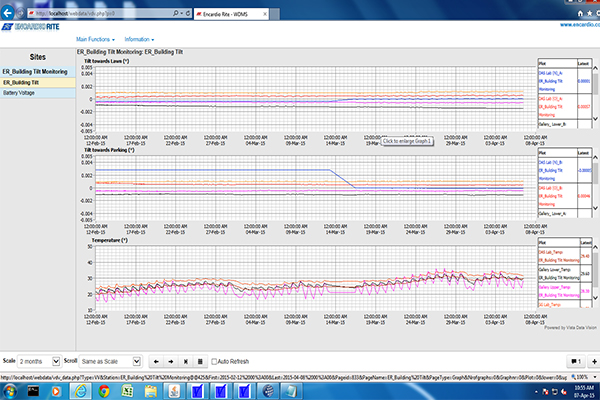
Figure 3: Graphical Representation of the Output from ESDL-30 Data Logger on a PC
The users can have two types of access - any user with lower level access can only view or access the data whereas a higher level user has the authority to set or modify some of the settings.
No special software is needed for accessing the user sites as the information can be viewed using most standard and popular web browsers like Microsoft Internet Explorer, Mozilla Firefox, Google Chrome, etc.
Do check out the video on how to configure ESDL-30 SDI-12 Data Logger with ESDL-30 UNI Application Software.
Specifications of Model ESDL-30 Data Logger
| Input | Sensor with SDI-12 signal interface |
| No. of channels | 3 |
| No. of sensors/channel | 61 |
| Scan/upload interval | 5 seconds to 168 hours |
| Memory capacity | Flash Memory (64-Mbit); 2 Million data points |
| Data output format | CSV text file. Can be easily imported into many third-party applications like Microsoft® Excel |
| SDI-12 version | Version 1.3 |
| Communication port | RS-232 (Standard) 115 kbps |
| Temp. measurement range | -20 to +70°C with 0.1°C resolution |
Operating temperature range | -30° to 70°C |
| Humidity | 100 % |
| Power supply | 2 x D size 3.6 V/19 Ah Lithium cells, or 2 x D size 1.5 V Alkaline high power cells, or 12V SMF battery chargeable from AC mains or solar panel |
| Housing | Corrosion-resistant weatherproof enclosure |
| Antenna (in telemetry option) | Built-in or separately mounted antenna |
| Dimensions LxWxH | 220 x 140 x 90 mm |
2. Model ESCL-10VT Single Channel Data Logger for Vibrating Wire Sensors:
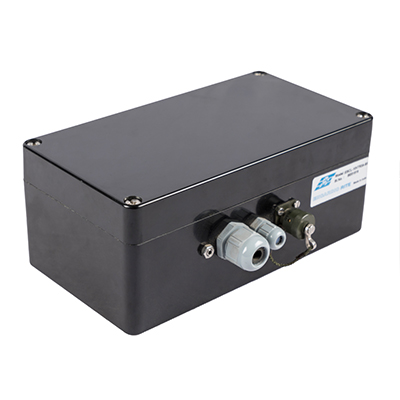
The Model ESCL-10VT is a single-channel vibrating wire data logger, designed for monitoring a single vibrating wire sensor (including temperature) such as a piezometer, crack meter, or displacement transducer. This data logger uses a Bluetooth modem to interface with the mobile phone. The data logger can be connected through a mobile phone using ESCL-10VT application software. The data logger can additionally monitor barometric pressure and rainfall, using a tipping bucket rain gauge.
The Model ESCL-10VT-BX data logger can be programmed to measure from 5 seconds to 168 hours in linear mode. The data logger comes with several power supply options. It has Windows-based application software with features that allow the user to set the sensor calibration coefficients, recording intervals, data logger or borehole code (identification tag numbers), sensor serial number, real-time clock time, etc. of the data logger conveniently.
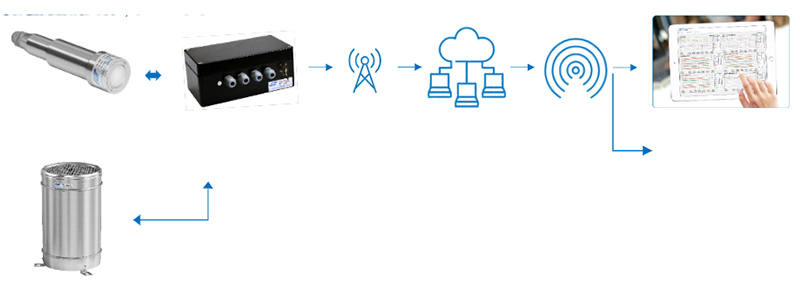
Figure 1: Block Diagram of ESCL-10VT Data Logger
The user can monitor readings and GPRS signal strength for diagnostic purposes. Users can also start or stop, scan, or manage data files, download data from the data logger, perform data correction, and save and export the data files.
ESCL-10VT-BX is a rugged data logger that can be used in a variety of applications to provide accurate and reliable data. It features a wide operating temperature range, dependable stand-alone operation, low power consumption, compatibility with many telecommunication options, and flexibility to support a variety of measurement and control applications. It is of durable construction and very suitable for unattended applications.
The data retrieval and transmission process for ESCL-10VT is similar to that of the ESDL-30 data logger.
Specifications of Model ESCL-10VT Single Channel Data Logger
| Input | Pressure sensor |
| Resolution | 18 bits (better than 1 mm for a 70 m WC sensor) |
| Temperature measurement range | -20 to +70°C with 0.1°C resolution |
| Logging interval | 5 seconds to 168 hours |
| Memory capacity | 8 MB Flash RAM. Can store 3,145,728 data points |
| Data output format | CSV text file. Can be easily imported into many third-party applications like Microsoft® Excel |
| Communication port | One RS-232 serial port. Interface cable for connecting to USB 2.0 port supplied as standard |
| Operating temperature range | -30 to 70ºC |
| Power supply boxed version (BX) | 2 x D size 3.6 V/19 Ah Lithium cells, or 2 x D size 1.5 V Alkaline high power cells, or 12 V SMF battery chargeable from solar panels, or 12V SMF battery chargeable from the AC mains |
| Housing | Box: Weather-proof enclosure< Cylindrical: Corrosion-resistant stainless steel, AISI grade 316L. |
| Dimensions (BX) (WxLxH) | 120x 220 x 91 (mm) for box version with suffix BX |
| Humidity | 100 % |
| Antenna (In telemetry option) | Quad Band GSM/GPRS/ EDGE, 850/800/1800/1900 MHz |
| Modem (in telemetry option) | Built-in or separate mounted antenna available |